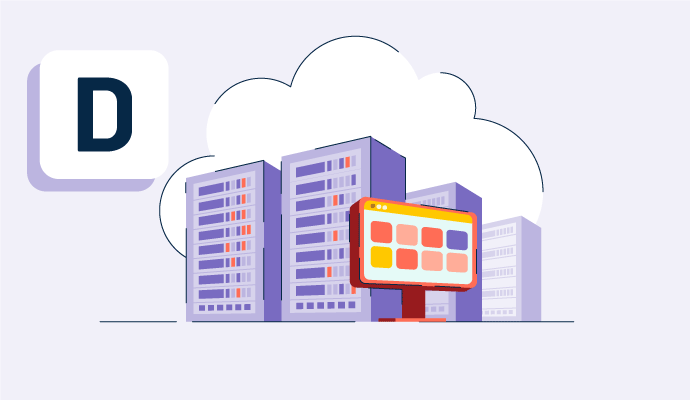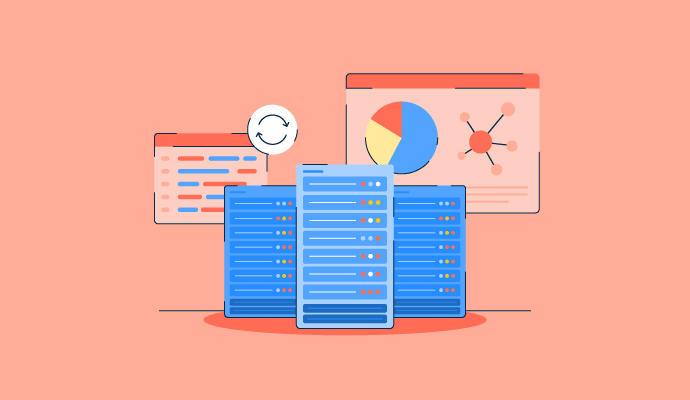What is a data center?
A data center is a specialized facility that houses interconnected computers, storage systems, and computing infrastructure. Its primary purpose is to enable organizations to gather, process, store, and distribute vast data volumes. It’s pivotal for businesses for day-to-day operations as it supports applications, services, and data storage, making it an asset for an organization.
Enterprise data centers have evolved to encompass multiple functionalities in modern times. They include provisions for securing and safeguarding cloud computing resources alongside the traditional in-house, on-site resources. Many organizations leverage data center networking solutions to manage information flowing between data centers and other infrastructural assets.
Types of data centers
On-premises data centers have transformed into hybrid models, allowing networks, applications, and workloads to be virtualized across private and public clouds. There are many types of data centers on the market.
- Enterprise data centers are primarily built and utilized by individual organizations for their internal operations, and they’re widespread among large technology companies.
- Colocation (colo) data centers operate as rental properties, providing space and resources to those seeking data center facilities for rent.
- Managed service data centers act as third-party providers, offering services like data storage and computing directly to customers.
- Cloud data centers are distributed facilities and are sometimes made available to customers through third-party managed service providers.
Benefits of data centers
Data centers support nearly all the enterprise's computational processes, storage, network infrastructure, and business applications. It offers the following benefits to businesses:
- Enhanced security. Data centers with robust physical and digital security measures safeguard the company’s data from theft, unauthorized access, and natural disasters.
- Heightened reliability. Data centers help ensure data safety during power outages. They employ redundant power supplies and backup generators to maintain data safety. Strict environmental controls protect equipment from dust, water, and extreme temperatures.
- Increased productivity. Data centers free office space by storing data off-site. It grants 24/7 access to the data, allowing business owners to work anytime and anywhere, ultimately increasing productivity.
- Expanded storage capacity. Data centers possess ample space and resources to store large volumes of data. They have scalable infrastructure to easily and quickly increase storage capacity without compromising security or performance.
Use cases of data centers
Data center operations include establishing and managing network resources, ensuring data center security, and monitoring power and cooling systems. The type of data center can vary based on the size, reliability, and redundancy required to meet the specific IT needs of the operating enterprises.
Here are the most common use cases of data centers:
- Leveraging on-premises data center investment. Organizations with significant investments in in-house data centers equipped with physical security, multiple power feeds, generators, and uninterruptible power supply (UPS) equipment, aim to maximize their capital by meeting uptime requirements and obtaining the best value for their investment.
- High-demand workloads. Virtual desktop infrastructure (VDI) workloads are commonly maintained in on-premises data centers due to their critical reliance on hardware and network performance. Many IT teams prefer in-house VDI servers and networks to minimize latency.
- Lots of ethernet-connected instruments or devices. Manufacturing facilities or laboratories with ethernet-connected machine tools or instruments often require local server hardware, applications, and control to accommodate special software or latency specifications.
Key aspects of a data center
Data center design incorporates various crucial components, including routers, switches, firewalls, storage systems, servers, and application delivery controllers. Since these elements store and manage vital business data and applications, ensuring data center security is paramount during design. Together, these components provide:
- Network infrastructure. It facilitates connectivity between servers (both physical and virtualized), data center services, storage, and external endpoints such as end-user locations.
- Computing resources. Applications act as the driving force within a data center, and servers provide processing power, memory, local storage, and network connectivity to support these applications.
- Data center infrastructure standards are widely governed by American National Standards Institute/Telecommunications Industry Association (ANSI/TIA-942). This includes ANSI/TIA-942-ready certification for compliance with four data center tiers, each offering varying redundancy and fault tolerance levels.
Best practices to streamline data center operations
A data center's primary purpose is storing, transporting, and providing access to digital data. Ensure smooth operations by following these best practices.
- Measure power usage effectiveness (PUE). Characterize efficiency performance with PUE ratio to reduce non-computing energy use, such as cooling and power distribution. Frequent measurement is vital, capturing data over the year to account for seasonal variations.
- Manage airflow. Efficient data center operation begins with good airflow management. Minimize hot and cold air mixing through well-designed containment. Utilize thermal modeling for optimization without significant disruptions.
- Adjust the thermostat. Raise the cold aisle temperature to save energy. Setting temperatures at 80°F or higher, in line with equipment specifications, enables free cooling days when using economizers.
- Use free cooling. Minimize chiller use by utilizing free cooling methods like low-temperature ambient air or water-side economizers. Chillers are major energy consumers, presenting significant savings opportunities.
- Optimize power distribution. Reduce power conversion steps, specifying efficient equipment transformers. High-efficiency UPS models significantly reduce data center power distribution losses while keeping high voltage close to the load helps minimize line losses.
Data center vs. data warehouse
Data centers are more extensive facilities designed to house all IT equipment, servers, and local data storage devices. It’s a central hub that consolidates all computer-related components of a business.
A data warehouse is a specialized data management system businesses use to conduct business intelligence (BI) endeavors. It houses vast volumes of historical data. The data in a data warehouse is sourced from different origins, including application log files.
Learn more about data warehouse solutions and discover how businesses use them in decision making.

Sagar Joshi
Sagar Joshi is a former content marketing specialist at G2 in India. He is an engineer with a keen interest in data analytics and cybersecurity. He writes about topics related to them. You can find him reading books, learning a new language, or playing pool in his free time.

